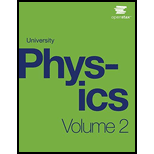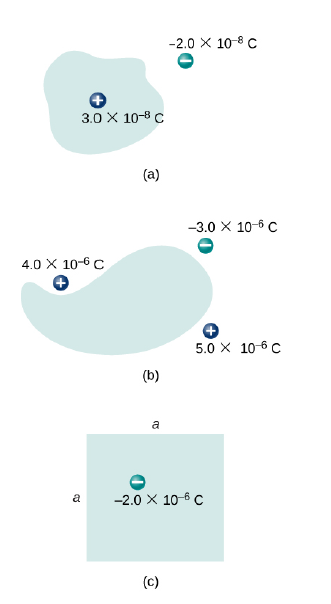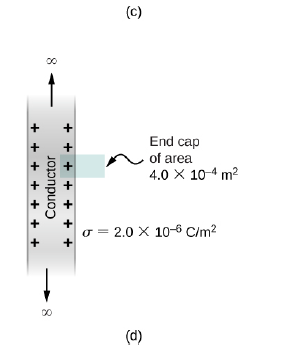
University Physics Volume 2
18th Edition
ISBN: 9781938168161
Author: OpenStax
Publisher: OpenStax
expand_more
expand_more
format_list_bulleted
Concept explainers
Textbook Question
thumb_up100%
Chapter 6, Problem 31P
Find the electric flux through the closed surface whose cross-sections are shown below.


Expert Solution & Answer
Trending nowThis is a popular solution!

Students have asked these similar questions
No chatgpt pls will upvote
You are standing a distance x = 1.75 m away from this mirror. The object you are looking at is y = 0.29 m from the mirror. The angle of incidence is θ = 30°. What is the exact distance from you to the image?
For each of the actions depicted below, a magnet and/or metal loop moves with velocity v→ (v→ is constant and has the same magnitude in all parts). Determine whether a current is induced in the metal loop. If so, indicate the direction of the current in the loop, either clockwise or counterclockwise when seen from the right of the loop. The axis of the magnet is lined up with the center of the loop. For the action depicted in (Figure 5), indicate the direction of the induced current in the loop (clockwise, counterclockwise or zero, when seen from the right of the loop). I know that the current is clockwise, I just dont understand why. Please fully explain why it's clockwise, Thank you
Chapter 6 Solutions
University Physics Volume 2
Ch. 6 - Check Your Understanding What angle should there...Ch. 6 - Check Your Understanding If the electric field in...Ch. 6 - Check Your Understanding Calculate the electric...Ch. 6 - Check Your Understanding Check that the electric...Ch. 6 - Check Your Understanding A thin straight wire has...Ch. 6 - Check Your Understanding How will the System above...Ch. 6 - Discuss how to orient a planar surface of area A...Ch. 6 - What are the maximum and minimum values of the...Ch. 6 - The net electric flux crossing a closed surface is...Ch. 6 - The net electric flux crossing an open surface is...
Ch. 6 - Two concentric spherical surfaces enclose a point...Ch. 6 - Compare the electric flux through the surface of a...Ch. 6 - (a) If the electric flux through a closed surface...Ch. 6 - Discuss how Gauss's law would be affected if the...Ch. 6 - Discuss the similarities and differences between...Ch. 6 - Discuss whether Gauss's law can be applied to...Ch. 6 - Is the term in Gauss's law the electric field...Ch. 6 - Reformulate Gauss's law by choosing the unit...Ch. 6 - Would Gauss's law be helpful for determining the...Ch. 6 - Discuss the role that symmetry plays in the...Ch. 6 - Discuss the restrictions on the Gaussian surface...Ch. 6 - Is the electric field inside a metal always zero?Ch. 6 - Under electrostatic conditions, the excess charge...Ch. 6 - A charge q is placed in the cavity of a conductor...Ch. 6 - The conductor in the preceding figure has an...Ch. 6 - A uniform electric field of magnitude 1.1104 N/C...Ch. 6 - Calculate the flux through the sheet of the...Ch. 6 - Find the electric flux through a rectangular area...Ch. 6 - The electric flux through a square-shaped area of...Ch. 6 - Two large rectangular aluminum plates of area 150...Ch. 6 - A square surface of area 2 cm2 is in a space of...Ch. 6 - A vector field is pointed along the z-axis,...Ch. 6 - Consider the uniform electric field...Ch. 6 - Repeat the previous problem, given that the...Ch. 6 - An infinite charged wire with charge per unit...Ch. 6 - Determine the electric flux through each surface...Ch. 6 - Find the electric flux through the closed surface...Ch. 6 - A point charge q is located at the center of a...Ch. 6 - A point charge of 10C is at an unspecified...Ch. 6 - A net flux of 1.0104 N ? m2/C passes inward...Ch. 6 - A charge q is placed at one of the comers of a...Ch. 6 - The electric flux through a cubical box 8.0 cm on...Ch. 6 - The electric flux through a spherical surface is...Ch. 6 - A cube whose sides are of length d is placed in a...Ch. 6 - Repeat the previous problem, assuming that the...Ch. 6 - A total charge 5.0106 C is distributed uniformly...Ch. 6 - Recall that in the example of a uniform charged...Ch. 6 - Suppose that the charge density of the spherical...Ch. 6 - A very long, thin wile has a uniform linear charge...Ch. 6 - A charge of 30C is distributed uniformly a...Ch. 6 - Repeat your calculations for the preceding...Ch. 6 - A total charge Q is distributed uniformly...Ch. 6 - When a charge is placed on a metal sphere, it ends...Ch. 6 - A large sheet of charge has a uniform charge...Ch. 6 - Determine if approximate cylindrical symmetry...Ch. 6 - A long silver rod of radius 3 cm has a charge of...Ch. 6 - ne electric field at 2 cm from the center of long...Ch. 6 - A long copper cylindrical shell of inner radius 2...Ch. 6 - Charge is distributed uniformly with a density p...Ch. 6 - Charge is distributed throughout a very long...Ch. 6 - The electric field 10.0 cm from the surface of a...Ch. 6 - Charge is distributed throughout a spherical shell...Ch. 6 - Charge is distributed throughout a spherical...Ch. 6 - Consider a uranium nucleus to be sphere of radius...Ch. 6 - The volume charge density of a spherical charge...Ch. 6 - An uncharged conductor with an internal cavity is...Ch. 6 - An uncharged spherical conductor S of radius R has...Ch. 6 - A positive point charge is placed at the angle...Ch. 6 - A long cylinder of copper of radius 3 cm is...Ch. 6 - An aluminum spherical ball of radius 4 cm is...Ch. 6 - A long cylinder of aluminum of radius R meters is...Ch. 6 - At the surface of any conductor in electrostatic...Ch. 6 - Two parallel plates 10 cm on a side are given...Ch. 6 - Two parallel conducting plates, each of...Ch. 6 - The surface charge density on a long straight...Ch. 6 - A point charge q=5.01012 C is placed at the center...Ch. 6 - A solid cylindrical conductor of radius a is...Ch. 6 - A vector field E (not necessarily an electric...Ch. 6 - Repeat the preceding problem, with E=2xi+3x2k.Ch. 6 - A circular area S is concentric with the origin,...Ch. 6 - (a) Calculate the electric flux through the open...Ch. 6 - Suppose that the electric field of an isolated...Ch. 6 - The electric field in a region is given by...Ch. 6 - Two equal and opposite charges of magnitude Q are...Ch. 6 - A fellow student calculated the flux through the...Ch. 6 - A 10cm10cm piece of aluminum foil of 0.1 mm...Ch. 6 - Two 10cm10cm pieces of aluminum foil of thickness...Ch. 6 - Two large copper plates facing each other have...Ch. 6 - The infinite slab between the planes defined by...Ch. 6 - A total charge Q is distributed uniformly...Ch. 6 - A non-conducting spherical shell of inner radius...Ch. 6 - Two non-conducting spheres of radii R1 and R2 are...Ch. 6 - A disk of radius R is cut in a non-conducting...Ch. 6 - Concentric conducting spherical shells carry...Ch. 6 - Shown below ale two concentric conducting...Ch. 6 - A point charge of q=5.0108 C is placed at the...Ch. 6 - Re-derive Gauss's law for the gravitational field,...Ch. 6 - An infinite plate sheet of charge of surface...Ch. 6 - A spherical lubber balloon carries a total charge...Ch. 6 - Find the electric field of a large conducting...
Additional Science Textbook Solutions
Find more solutions based on key concepts
What type of culture medium would increase the size of a bacterial capsule?
Laboratory Experiments in Microbiology (12th Edition) (What's New in Microbiology)
27. Consider the reaction.
Express the rate of the reaction in terms of the change in concentration of each of...
Chemistry: Structure and Properties (2nd Edition)
1.3 Obtain a bottle of multivitamins and read the list of ingredients. What are four chemicals from the list?
Chemistry: An Introduction to General, Organic, and Biological Chemistry (13th Edition)
With what geologic feature are the earthquakes in the mid-Atlantic associated?
Applications and Investigations in Earth Science (9th Edition)
Where are skeletal cartilages located?
Human Anatomy & Physiology (2nd Edition)
a. Draw the mechanism for the following reaction if it a involves specific-base catalysis. b. Draw the mechanis...
Organic Chemistry (8th Edition)
Knowledge Booster
Learn more about
Need a deep-dive on the concept behind this application? Look no further. Learn more about this topic, physics and related others by exploring similar questions and additional content below.Similar questions
- A planar double pendulum consists of two point masses \[m_1 = 1.00~\mathrm{kg}, \qquad m_2 = 1.00~\mathrm{kg}\]connected by massless, rigid rods of lengths \[L_1 = 1.00~\mathrm{m}, \qquad L_2 = 1.20~\mathrm{m}.\]The upper rod is hinged to a fixed pivot; gravity acts vertically downward with\[g = 9.81~\mathrm{m\,s^{-2}}.\]Define the generalized coordinates \(\theta_1,\theta_2\) as the angles each rod makes with thedownward vertical (positive anticlockwise, measured in radians unless stated otherwise).At \(t=0\) the system is released from rest with \[\theta_1(0)=120^{\circ}, \qquad\theta_2(0)=-10^{\circ}, \qquad\dot{\theta}_1(0)=\dot{\theta}_2(0)=0 .\]Using the exact nonlinear equations of motion (no small-angle or planar-pendulumapproximations) and assuming the rods never stretch or slip, determine the angle\(\theta_2\) at the instant\[t = 10.0~\mathrm{s}.\]Give the result in degrees, in the interval \((-180^{\circ},180^{\circ}]\).arrow_forwardWhat are the expected readings of the ammeter and voltmeter for the circuit in the figure below? (R = 5.60 Ω, ΔV = 6.30 V) ammeter I =arrow_forwardsimple diagram to illustrate the setup for each law- coulombs law and biot savart lawarrow_forward
- A circular coil with 100 turns and a radius of 0.05 m is placed in a magnetic field that changes at auniform rate from 0.2 T to 0.8 T in 0.1 seconds. The plane of the coil is perpendicular to the field.• Calculate the induced electric field in the coil.• Calculate the current density in the coil given its conductivity σ.arrow_forwardAn L-C circuit has an inductance of 0.410 H and a capacitance of 0.250 nF . During the current oscillations, the maximum current in the inductor is 1.80 A . What is the maximum energy Emax stored in the capacitor at any time during the current oscillations? How many times per second does the capacitor contain the amount of energy found in part A? Please show all steps.arrow_forwardA long, straight wire carries a current of 10 A along what we’ll define to the be x-axis. A square loopin the x-y plane with side length 0.1 m is placed near the wire such that its closest side is parallel tothe wire and 0.05 m away.• Calculate the magnetic flux through the loop using Ampere’s law.arrow_forward
- Describe the motion of a charged particle entering a uniform magnetic field at an angle to the fieldlines. Include a diagram showing the velocity vector, magnetic field lines, and the path of the particle.arrow_forwardDiscuss the differences between the Biot-Savart law and Coulomb’s law in terms of their applicationsand the physical quantities they describe.arrow_forwardExplain why Ampere’s law can be used to find the magnetic field inside a solenoid but not outside.arrow_forward
- 3. An Atwood machine consists of two masses, mA and m B, which are connected by an inelastic cord of negligible mass that passes over a pulley. If the pulley has radius RO and moment of inertia I about its axle, determine the acceleration of the masses mA and m B, and compare to the situation where the moment of inertia of the pulley is ignored. Ignore friction at the axle O. Use angular momentum and torque in this solutionarrow_forwardA 0.850-m-long metal bar is pulled to the right at a steady 5.0 m/s perpendicular to a uniform, 0.650-T magnetic field. The bar rides on parallel metal rails connected through a 25-Ω, resistor (Figure 1), so the apparatus makes a complete circuit. Ignore the resistance of the bar and the rails. Please explain how to find the direction of the induced current.arrow_forwardFor each of the actions depicted, determine the direction (right, left, or zero) of the current induced to flow through the resistor in the circuit containing the secondary coil. The coils are wrapped around a plastic core. Immediately after the switch is closed, as shown in the figure, (Figure 1) in which direction does the current flow through the resistor? If the switch is then opened, as shown in the figure, in which direction does the current flow through the resistor? I have the answers to the question, but would like to understand the logic behind the answers. Please show steps.arrow_forward
arrow_back_ios
SEE MORE QUESTIONS
arrow_forward_ios
Recommended textbooks for you

 Principles of Physics: A Calculus-Based TextPhysicsISBN:9781133104261Author:Raymond A. Serway, John W. JewettPublisher:Cengage Learning
Principles of Physics: A Calculus-Based TextPhysicsISBN:9781133104261Author:Raymond A. Serway, John W. JewettPublisher:Cengage Learning Physics for Scientists and Engineers: Foundations...PhysicsISBN:9781133939146Author:Katz, Debora M.Publisher:Cengage Learning
Physics for Scientists and Engineers: Foundations...PhysicsISBN:9781133939146Author:Katz, Debora M.Publisher:Cengage Learning Physics for Scientists and Engineers, Technology ...PhysicsISBN:9781305116399Author:Raymond A. Serway, John W. JewettPublisher:Cengage Learning
Physics for Scientists and Engineers, Technology ...PhysicsISBN:9781305116399Author:Raymond A. Serway, John W. JewettPublisher:Cengage Learning College PhysicsPhysicsISBN:9781285737027Author:Raymond A. Serway, Chris VuillePublisher:Cengage Learning
College PhysicsPhysicsISBN:9781285737027Author:Raymond A. Serway, Chris VuillePublisher:Cengage Learning Physics for Scientists and EngineersPhysicsISBN:9781337553278Author:Raymond A. Serway, John W. JewettPublisher:Cengage Learning
Physics for Scientists and EngineersPhysicsISBN:9781337553278Author:Raymond A. Serway, John W. JewettPublisher:Cengage Learning


Principles of Physics: A Calculus-Based Text
Physics
ISBN:9781133104261
Author:Raymond A. Serway, John W. Jewett
Publisher:Cengage Learning

Physics for Scientists and Engineers: Foundations...
Physics
ISBN:9781133939146
Author:Katz, Debora M.
Publisher:Cengage Learning

Physics for Scientists and Engineers, Technology ...
Physics
ISBN:9781305116399
Author:Raymond A. Serway, John W. Jewett
Publisher:Cengage Learning

College Physics
Physics
ISBN:9781285737027
Author:Raymond A. Serway, Chris Vuille
Publisher:Cengage Learning

Physics for Scientists and Engineers
Physics
ISBN:9781337553278
Author:Raymond A. Serway, John W. Jewett
Publisher:Cengage Learning
Electric Fields: Crash Course Physics #26; Author: CrashCourse;https://www.youtube.com/watch?v=mdulzEfQXDE;License: Standard YouTube License, CC-BY